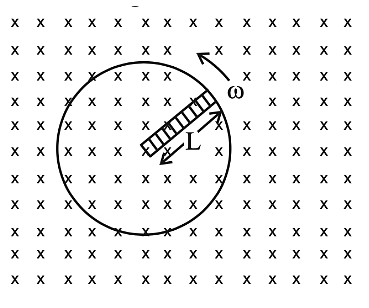A metallic rod of length ' \(L\) ' is rotated with an angular speed of ' \(\omega\) ' normal to a uniform magnetic field ' \(B\) ' about an axis passing through one end of rod as shown in figure. The induced emf will be :

A metallic rod of length ' \(L\) ' is rotated with an angular speed of ' \(\omega\) ' normal to a uniform magnetic field ' \(B\) ' about an axis passing through one end of rod as shown in figure. The induced emf will be :
Show Hint
For a rotating rod in a uniform magnetic field, the induced EMF is given by:
\[ \epsilon = \frac{1}{2} B L^2 \omega, \]
where \( B \) is the magnetic field, \( L \) is the length of the rod, and \( \omega \) is the angular speed.
\(\frac{1}{2} B ^2 L ^2 \omega\)
\(\frac{1}{4} BL ^2 \omega\)
\(\frac{1}{2} BL ^2 \omega\)
\(\frac{1}{4} B ^2 L \omega\)
The Correct Option is C
Approach Solution - 1
When the rod rotates about one end in a uniform magnetic field, the induced EMF is calculated using Faraday’s law. The differential EMF generated across an infinitesimal length \( dx \) of the rod is:
\[ d\epsilon = Bv \, dx \]
where:
- \( v = \omega x \) is the linear velocity of the element at a distance \( x \) from the axis of rotation,
- \( B \) is the uniform magnetic field.
Substitute \( v = \omega x \):
\[ d\epsilon = B(\omega x) \, dx = B\omega x \, dx \]
The total EMF is obtained by integrating \( d\epsilon \) along the length of the rod:
\[ \epsilon = \int_0^L B\omega x \, dx \]
\[ \epsilon = B\omega \int_0^L x \, dx \]
\[ \epsilon = B\omega \left[ \frac{x^2}{2} \right]_0^L = B\omega \frac{L^2}{2} \]
Thus, the total induced EMF is:
\[ \epsilon = \frac{1}{2} BL^2 \omega \]
Approach Solution -2
The correct answer is (C) : $\frac{1}{2} BL ^2 \omega $
∫dε=∫B(ωx)dx
ε=Bω0∫Lxdx=2BωL2
Top Questions on Electromagnetic induction
- A vertically held bar magnet is dropped along the axis of a copper ring having a cut as shown in the diagram. The acceleration of the falling magnet is:

- CBSE CLASS XII - 2025
- Physics
- Electromagnetic induction
A coil of area A and N turns is rotating with angular velocity \( \omega\) in a uniform magnetic field \(\vec{B}\) about an axis perpendicular to \( \vec{B}\) Magnetic flux \(\varphi \text{ and induced emf } \varepsilon \text{ across it, at an instant when } \vec{B} \text{ is parallel to the plane of the coil, are:}\)
- JEE Main - 2025
- Physics
- Electromagnetic induction
- A rectangular metallic loop is moving out of a uniform magnetic field region to a field-free region with a constant speed. When the loop is partially inside the magnetic field, the plot of the magnitude of the induced emf \( (\varepsilon) \) with time \( (t) \) is given by: \includegraphics[width=1\linewidth]{3.png}
- JEE Main - 2025
- Physics
- Electromagnetic induction
- If \( B \) is magnetic field and \( \mu_0 \) is permeability of free space, then the dimensions of \( \frac{B}{\mu_0} \) is:
- JEE Main - 2025
- Physics
- Electromagnetic induction
- Consider a long straight wire of a circular cross-section (radius \( a \)) carrying a steady current \( I \). The current is uniformly distributed across this cross-section. The distances from the center of the wire's cross-section at which the magnetic field (inside the wire, outside the wire) is half of the maximum possible magnetic field, anywhere due to the wire, will be:
- JEE Main - 2025
- Physics
- Electromagnetic induction
Questions Asked in JEE Main exam
- The number of ways, 5 boys and 4 girls can sit in a row so that either all the boys sit together or no two boys sit together is:
- JEE Main - 2025
- Permutation and Combination
- Given a thin convex lens (refractive index \( \mu_2 \)), kept in a liquid (refractive index \( \mu_1, \mu_1<\mu_2 \)) having radii of curvature \( |R_1| \) and \( |R_2| \). Its second surface is silver polished. Where should an object be placed on the optic axis so that a real and inverted image is formed at the same place?
- JEE Main - 2025
- Optics and Refraction
- To obtain the given truth table, the following logic gate should be placed at G

- JEE Main - 2025
- Logic gates

For the circuit shown above, the equivalent gate is:
- JEE Main - 2025
- Logic gates
Let \( f : \mathbb{R} \to \mathbb{R} \) be a twice differentiable function such that \[ (\sin x \cos y)(f(2x + 2y) - f(2x - 2y)) = (\cos x \sin y)(f(2x + 2y) + f(2x - 2y)), \] for all \( x, y \in \mathbb{R}. \)
If \( f'(0) = \frac{1}{2} \), then the value of \( 24f''\left( \frac{5\pi}{3} \right) \) is:
- JEE Main - 2025
- Differential Calculus
Concepts Used:
Electromagnetic Induction
Electromagnetic Induction is a current produced by the voltage production due to a changing magnetic field. This happens in one of the two conditions:-
- When we place the conductor in a changing magnetic field.
- When the conductor constantly moves in a stationary field.
Formula:
The electromagnetic induction is mathematically represented as:-
e=N × d∅.dt
Where
- e = induced voltage
- N = number of turns in the coil
- Φ = Magnetic flux (This is the amount of magnetic field present on the surface)
- t = time
Applications of Electromagnetic Induction
- Electromagnetic induction in AC generator
- Electrical Transformers
- Magnetic Flow Meter